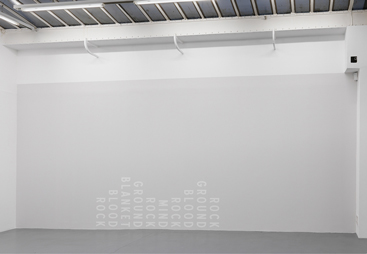
Born in 1970 in Rochester (US)
Lives and works in Cambridge (US)

2009
Wall painting
dimensions variables
Year of Purchase: 2014
“I walked through the mountains today.” 1 — Robert Walser A Little Ramble
If outdoor walking has informed much of Helen Mirra’s practice to record sounds (Hourly Directional, with Ernst Karel, 2013), imprint objects found en route (gehend (Field Recordings 1–3), 2011), or collect rocks in the Swiss Alps (33 Bergwanderwege, 2009), walking – understood as the artist’s compelling ‘task’ – then seems less instrumental, but rather inconspicuously aimless as in Walser’s writerly montages. Mindful in the methods of making, hers is a practice that both enacts and exceeds phenomenological concerns. 2 In stressing that what is already there, Mirra foregrounds materials and processes, while embracing chance findings along the path. Yet, it is an altogether different point of view, ‘Rück-sicht’ even, in both senses of the term, that matters. 3 This receptivity towards the world is equally reflected in Mirra’s text pieces.4
Breaking the linearity of previous – often indexical – short forms, Glacier (2009) is composed of ten words, painted one after the other in capital letters vertically onto the wall. In this instance, the shiny white lettering ends just above the exhibition floor. While Mirra makes use of mostly mono-syllabic nouns: ‘rock’, ‘ground’, ‘blood’, ‘mind’ with the exception of ‘blanket’, from Old French blanc ‘white’, they are sequenced and spaced evenly, thus foregrounding the intervals in-between. A distinct rhythm is created, based on repetition and difference. Consider the words ‘rock’ – repeated four times, employed as symmetrical framing device – as well as ‘mind’ – the latter marks the lowest, albeit central position within the piece. Undoubtedly, these words point to Mind of a Rock, which served as the overarching title to Mirra’s 2009 solo exhibition in which Glacier was first shown. 5
Playing on a semantic and pronounced visual reading akin to concrete poetry, Glacier seems as much to separate as to connect, rising and falling, as if to carve out crevasses or sculpt highland ice fields. In its very definition, a glacier is not only an accumulation of snow and ice, formed through time, in constant slow movement, but a dynamic, self-regulated ‘sculptural’ process, subject to temperature and laws of gravity. 6 Different temporalities and materializations coalesce, resulting in layers above layers – thickened, solidified. Yet, what is once solid may turn liquid or melt “into thin air”. Today, the earth’s glaciers are, without doubt, the most visible evidence of global warming.
In reference to the artist’s research on panpsychism “a theory that mind exists, in all living and non-living things in consideration of the nature of consciousness and mind,“ 7 Aldo Leopold’s Thinking Like a Mountain (1949) comes to mind, extending from rocks to the mountain as such. “Leopold considers the locus of thinking to lie outside individual human beings,” as Michael Marder explains, “in the interactive relation between the living and their environment. The mountain is a subject of thinking, insofar as it maintains a fragile balance among all organic and inorganic entities that populate it.” 8
Un-inhabitable, a place of alpine danger, of imminent death, but also one of salvation, the mountain and its opaque, often hidden openings conjures up the notion of “bergen” (from old high German ‘bergan’), meaning to ‘save’, ‘salvage’, or ‘rescue’, as well as to ‘protect’, ‘conceal’ or ‘hide’, but also to ‘contain’, ‘hold’. 9 While the floor pieces in the above-mentioned exhibition consisted of rocks collected from Mirra’s hikes in the Swiss Alps, transported in her rucksack and placed onto military blankets, folded in the size of an “unfolded trail map” in the exhibition space, Glacier, invites the reader-viewer to join in the act of walking, in engaging fully with the work. “Walking”, as Christina Végh notes elsewhere, “is manifesting itself as a demeanor of concentrated attention. It is a matter of discovering an ability to perceive abundance in the simple […].” 10 Or, to put it differently in returning to Walser’s Little Ramble: “We don’t need to see anything out of the ordinary. We already see so much.”
Anja Isabel Schneider
1 Robert Walser A Little Ramble, translated by Tom Whalen, New Directions, 2013.
2 These include “a broad array of scientific, historical, and aesthetic references which, as she says, are embedded in her decision-making and compressed into the things she makes.” See
Heidi Zuckerman Jacobson “Helen Mirra Matrix 209 65 instants” http://archive.bampfa.berkeley.edu/images/art/matrix/209/MATRIX_209_Helen_Mirra.pdf, accessed 21 March 2016.
3 Rücksicht in German means both ‘consideration / considération’ as well as ‘looking behind / regarder vers l’arrière’. Mirra states, in describing the act of walking and looking: “What I would do more is consider the ground behind and to the sides, beneath and in front is more apparent.” See Peter Eleey / Helen Mirra “DIALOGUE, APRIL–JUNE 2011” in HELEN MIRRA. GEHEND, argobooks, 2013.
4 Writing, one might argue here, is in itself a process of (re)collection.
5 Mirra had just spent a year in Switzerland. For years, I kept the press release, in between books, after seeing her show. In the artist’s statement, that accompanied her work, she recalls a Robert Bresson film poster ‘Lancelot du Lac’ by Raymond Savignac. It depicts both knight and horse turned upside down. A stream of blood emits from the knights’ armour, forming a red puddle of blood on the ground.
6 Pratap Singh & Vijay P. Singh Snow and glacier hydrology. Netherlands: Kluwer Academic Publishers, 2001.
7 David Skrbina Panpsychism in the West (Bradford Books), MIT Press, 2007.
8 Michael Marder “On the Mountains, or the Aristocracies of Space”, in Environment, Space, Place: Volume 4, Issue 2, Fall 2012.
9 If employed as a noun in British English, ‘bergen’ denotes a military rucksack.
10 See Christina Végh ”Walking and Bending” in HELEN MIRRA. GEHEND, argobooks, 2013